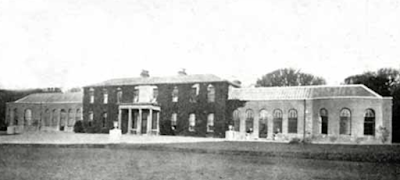LORD GEORGE AUGUSTUS HILL (1801-79), fifth son of Arthur, 2nd Marquess of Downshire, married firstly, in 1834, Cassandra Jane, fifth daughter of Edward Austen Knight (the novelist Jane Austen's brother), of Godmersham Park, Kent, and had issue,
ARTHUR BLUNDELL GEORGE SANDYS;He wedded secondly, in 1847, Louisa, daughter of Edward Knight, and had further issue,
Augustus Charles Edward (1839-1908);
Norah Mary Elizabeth.
Cassandra Jane Louisa;Lord George was succeeded by his eldest son,
George Marcus Wandsbeck (1849-1911).
ARTHUR BLUNDELL GEORGE SANDYS HILL (1837-1923), of Gweedore, County Donegal, who espoused, in 1871, Helen Emily, daughter of the Most Rev and Rt Hon Richard Chenevix-Trench, Lord Archbishop of Dublin, and had issue.
BALLYARR HOUSE, near Ramelton, County Donegal, was built ca 1780.
It was acquired in 1842 by Lord George Hill.
Lord George had previously bought 23,000 acres in and around Gweedore.
Ballyarr’s most famous visitor during Lord George's time was the historian Thomas Carlyle, and it was he who later described the house as ‘a farm-like place’ with a ‘piazza’, an Italian style square that was then considered fashionable.After Lord George's death, in 1879, the house passed through his family until it was sold in 1900, along with the adjacent mill, to William Russell.
It remained in the Russells’ hands until it was bought in 1974 by Ian Smith, a former hotelier and war hero, and his artist wife Peggy.
One wing of the house, which had been barely altered since Lord George’s time, had fallen into ruin and was demolished.
However, one large fanlight window was saved and later erected in a house in Castle Street, Ramelton, known as ‘ The House on the Brae’, owned by Ramelton Heritage Society.
Ballyarr House was bought in 1981 by Andy O’Loghlin, bank manager, and his wife Breda.
They sold it to Roy and Noreen Greenslade in 1989 and the following year they oversaw a substantial restoration in order to return the interior to something like its original Georgian appearance.
The drawing room and library were returned to their previous proportions, with the addition of new fireplaces.
Ceiling cornices in the main bedroom were restored.
The exterior front elevation was also stripped of its stucco to reveal the original stone-work.
LORD GEORGE HILL
In 1838, Lord George Augustus Hill purchased land in Gweedore and over the next few years expanded his holdings to 23,000 acres, including a number of offshore islands, the largest of which was Gola island.
He estimated that his lands had about 3,000 inhabitants, of whom 700 were rent payers.
Unlike previous landlords who often left their holdings and people alone, Lord George came to stay, and set about to improve the roads and bridges.
He had an advantage in that he knew the Irish language, the main language of the people of the area.
The first road into Gweedore was constructed in 1834 when the Board of Works constructed a road from Dunlewey to the Gweedore River and Lord George further improved the roads on his estate.
At Bunbeg he constructed a harbour and corn store and a general merchandise store.
By purchasing grain at the prices prevailing in Letterkenny, Lord George hoped to curb the practice of illicit distillation, which he perceived was one of the prime causes of distress in the area.
The suppression of illicit distillation was one thing in which Lord George had to admit he wasn't as successful as he would have liked.
Quite conveniently, although not mentioned by him or his admirers, the purchasing of grain from the tenants would have given them money with which to pay their rent. Potatoes were grown for their own needs.
About four miles from Bunbeg, up the Clady River, Lord George constructed a hotel, which he surrounded by a model farm.
Early editions of Hill's book were subtitled With Hints For Donegal Tourists, and this was, apart from demonstrating his agricultural improvements, the other purpose for writing Facts from Gweedore; he wanted people to come and stay in his hotel.
Hill also set up a shop in Bunbeg and imported a Scot named Mason to open a bakery.
Lord George was not for the "free market," and made sure that no one else opened up in opposition to him.
Margaret Sweeney was evicted for trying to set up a bakery without permission.
Almost immediately on taking up his land in Gweedore, Hill set about to improve the agricultural practices of his estate.
His tenants naturally were not so inclined to share the landlord's view of what was good agriculture and this became a bone of contention for many years even though Lord George was quite successful in abolishing the Rundale system.
Even he admitted that the re-organization of the farms was
a difficult task, and much thwarted by the people, as they naturally did not like that their old ways should be disturbed or interfered with...the opposition on the part of the people to the new system was vexatious and harassing.In 1888, there were 800 official tenancies on the Hill estate, which increased the next year to 920, due to sub-tenants being recognized as official tenants, after a settlement negotiated between the landlord and the parish priest.
Downshire arms courtesy of European Heraldry. First published in November, 2011.














































